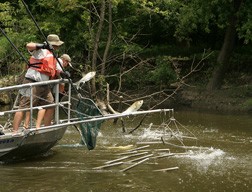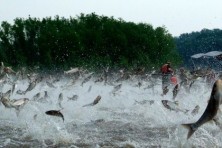No Asian Carp DNA Found in Water Samples
- Share
- Tweet
- Pin
- Share
Water samples collected from Sturgeon Bay last month and analyzed for evidence of Asian carp DNA have come back negative, state officials announced.
“We’re obviously happy that the results came back negative. It’s a good indication that there are not Asian carp in the bay and underscores the importance of continuing our efforts to keep Asian carp out of the Great Lakes,” says Mike Staggs, fisheries director for the Department of Natural Resources.

U.S. Fish and Wildlife Service employees electrofish for invasive Asian carp at the Big Muddy National Wildlife Refuge in Missouri on the Mississippi River. Photo by the USFWS.
The U.S. Fish and Wildlife Service and DNR had collected 150 water samples from Sturgeon Bay on Nov. 12 and 13 as a follow up to a single positive detection of Asian carp DNA in samples collected from the bay earlier in the year.
“Sampling was completed as part of a Great Lakes wide early detection program intended to monitor for many different invasive species, including Asian carp,” says Todd Turner, the U.S. Fish and Wildlife Service’s Assistant Regional Director for Midwest Fisheries. “We continue to work closely with our state partners to use eDNA as a tool to investigate invasive species across the Midwest Region.”
Repeated detections over time of environmental DNA, or eDNA for short, increase the likelihood of a persistent source of genetic material in the area where the sample was collected, possibly indicating the presence of live fish or other repeated source, says Bob Wakeman, DNR’s aquatic invasive species coordinator.
Environmental DNA is released into water with the urine, feces and scales of live fish but other possible sources could include a bait bucket that accidentally contained young Asian carp, water transported in the live well of a recreational boat that had recently been used in Asian carp infested waters, or feces from a migrating bird that had eaten an Asian carp, Wakeman says.
Asian carp species are invasive fish species that were introduced to southern fish farms in the 1970s, escaped, and have been making their way toward the Great Lakes. They are a serious concern because they can aggressively compete with native commercial and sport fish for food, says Bob Wakeman, DNR’s aquatic invasive species coordinator. Also, silver carp can injure boaters when the fish leap out of the water.
Asian carp environmental DNA has been found upstream of the electric dispersal barriers in Lake Calumet, seven miles from Lake Michigan on the Indiana-Illinois border, and in Lake Erie.
Sampling in Wisconsin waters for Asian carp eDNA had been negative until the single positive sample from Sturgeon Bay. Wakeman says Wisconsin will continue to work with the U.S. Fish and Wildlife Service and other partners to monitor Wisconsin waters of the Great Lakes for unwanted invasive species.
For more information, search the DNR website (dnr.wi.gov) for “Asian carp control efforts.”

